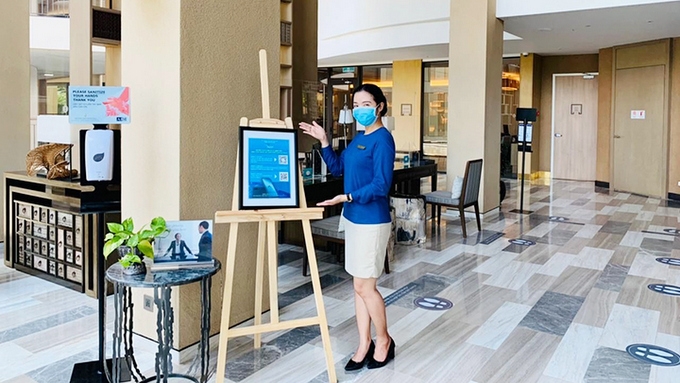Despite the many difficulties due to the COVID-19 pandemic, the Vietnamese tourism sector has continuously boosted its digital transformation as a series of applications on digital platforms have been studied and put into operation by the Vietnam National Administration of Tourism (VNAT), to increase the visitor experience and improve the tourism environment.

Instructions for checking safe destinations via “Safe Vietnam Tourism” app at a hotel. (Photo: NDO)
As the fourth industrial revolution spreads strongly, tourism cannot be left out. Tourism promotion and the development of tourism based on digital transformation is considered the future of the "smokeless industry".
In the context of epidemic prevention and control, this direction affirms its superiority over traditional tourism as transactions tend to be shifting to the digital realm.
Deputy Director of the Tourism Information Centre under VNAT Hoang Quoc Hoa said that having realised the importance and opportunities offered by digital transformation for tourism development, the tourism sector has proactively built a smart tourism ecosystem. Implementing the Prime Minister’s Decision No.1671/QD-TTg dated on November 30, 2018, approving the master project of information technology application in tourism during the 2018-2020 period, with an orientation to 2025, VNAT developed a diverse digital platform that integrates many essential features for both state management agencies, tour operators, tour guides and tourists.
Besides websites such as the VNAT websites at https://vietnamtourism.gov.vn, csdl.vietnamtourism.gov.vn and thongke.tourism.vn, the administration has paid much attention to promoting tourism via YouTube, Zalo and Facebook with diverse content that has been continuously updated. VNAT has also coordinated with the relevant ministries and agencies to issue the "Vietnamese card - A national card" that integrates many features such as tourism, healthcare, commerce, traffic, and education.
Recently, the tourism sector has promoted the deployment of applications on mobile platforms, contributing to bringing more convenience and interactivity to users. One example is the “Safe Vietnam Tourism” App, an effective tool to help protect tourists’ interests, especially during epidemic season. In addition to the utility providing specific information about destinations such as preferential policies and promotions, one outstanding feature of the app is that tourists can access the digital map to look up the safety level of the destinations.
According to a new regulation issued by the Ministry of Culture, Sports and Tourism, accommodation establishments nationwide must register and self-assess Covid-19 safety so that they are allowed serve guests. Following successful registration via http://safe.tourism.com.vn, they will be issued with a QR code to paste in easy-to-observe places such as their front desks or entrances. Visitors using a phone installed with the “Safe Vietnam Tourism” App just need to scan the QR code to check if the facilities have registered their safety standard with the state management agency and meet the criteria or not. This feature has been highly lauded by travel businesses and tourists for its efficiency.
To date, around 13,000 businesses and accommodation establishments have registered and self-assessed their COVID-19 safety. During the process of using travel services, this app also allows visitors directly comment on services’ quality. Last May, through the reflection of a German tourist on the “Safe Vietnam Tourism” app, functional forces have quickly found and fined a driver in Hanoi who put price pressure on tourists.
In addition to the application for tourists, VNAT has developed an app for tour guides with numerous diverse features that allow them to connect with tour operators to manage schedules and the number of visitors as well as quickly interact with customers for prompt contact and feedback.
Deputy Director of the Tourism Information Centre Hoang Quoc Hoa also note that the above two applications can be considered in the one set and are capable of linking with each other so that both service providers and consumers can connect best. These two apps’ interfaces will be changed to a more user-friendly manner and more features on e-payment and e-tickets will be developed in the near future.
Trang Anh
Translated by NDO